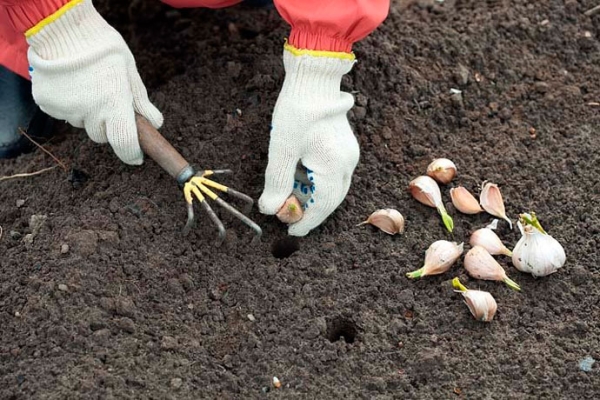Garlic belongs to the onion family. It is widely used in cooking and traditional medicine. The plant has a spicy taste and smell, is an excellent antiseptic. Agrotehnika it is quite simple and growing it is not a problem even for inexperienced gardeners. In this article we will talk about planting summer garlic in the spring.
Table of contents
When can I plant summer garlic, terms
The differences between them are as follows:
- winter forms arrows with air bulbs, through which it multiplies; summer shooter does not form and multiply teeth;
- summer bulb has a large number of teeth (up to 30 pieces), winter has about 10 teeth;
- the main advantage of the summer - long shelf life; it can be stored until the next harvest;
- planting dates of summer garlic: end of April - beginning of May, winter: mid-autumn.
To obtain a good harvest, it is necessary to plant summer garlic in open ground after the soil reaches a temperature above + 5-6 ° C.
This is explained by the formation and active growth of its roots and leaves occur only at low temperatures.
If the dates are shifted even by 1-2 weeks, the leaves and roots cease their active development, which will adversely affect the yield.
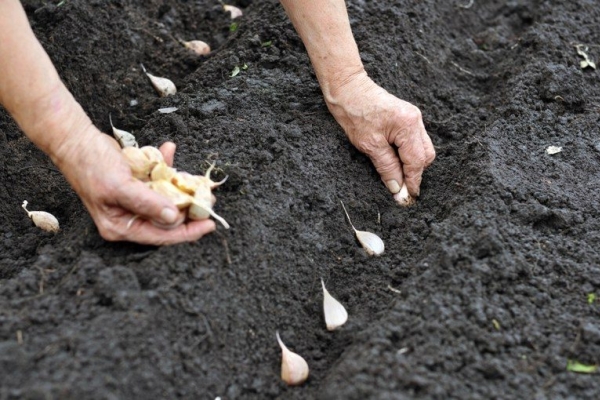
How to plant in the spring in the open ground
Correct plot for planting summer garlic should be on the sunny side.The soil should be fertile, with a neutral environment.
Acidic soils require lime liming. Culture grows best on loamy soil.
Preparation of bulbs for planting
Bulbs warm storage (stored at room temperature) are slightly immature. 2 months before planting, they are placed in the refrigerator.
With cold bulbs (grave) storage such a procedure is not necessary.
Then the selected cloves are sorted by size.
All teeth are sanitized. a solution of copper sulphate. For 8 hours before planting, the teeth are soaked in a warm solution of nitroammophos; the concentration is 5 g per 10 l of water.
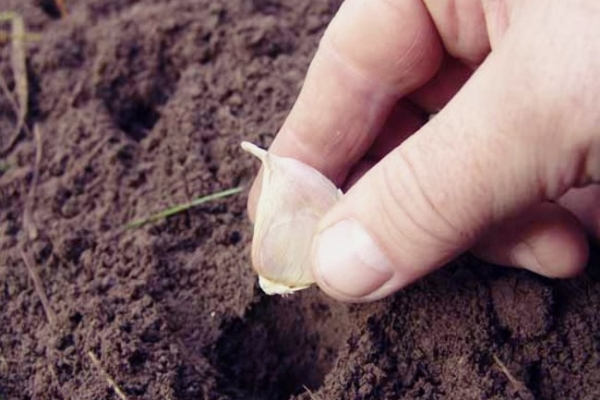
Preparation of beds
Garlic precursors may be leguminous or cruciferous plants. The culture also takes root well on soils where pumpkins or cucumbers were cultivated before it.
Since the root system of the bulbs is small, beds for him should not be more than 15 cm tall. The width of the beds is 80-90 cm.
Desirable before landing water the beds with saline (150 g of salt per 10 liters of water).
How to plant
Preliminary need Make furrows 5-8 cm deep on the beds. Planting is made with the tip of the clove to the top.
It is necessary to plant it into the ground at a depth of 2-3 cm from the surface to the tip of the tooth. The distance between the teeth is about 10 cm, between the rows - 15 cm. Large teeth are planted separately from the small and medium ones.
After landing and falling asleep ground need to feed the beds ammonium sulfate (20 g per 10 liters of water) in order to prevent pests from spoiling the seed.
Spring planting garlic:
Growing and caring for the future harvest and the first shoots
After the first shoots culture needs care and feeding. Nitrogenous fertilizers are preferred.
The calculation of the required number of complementary foods is determined on the basis of the sown area: per 1 sq. M. need 3 liters of mixture. After 10 days fertilizing repeat.
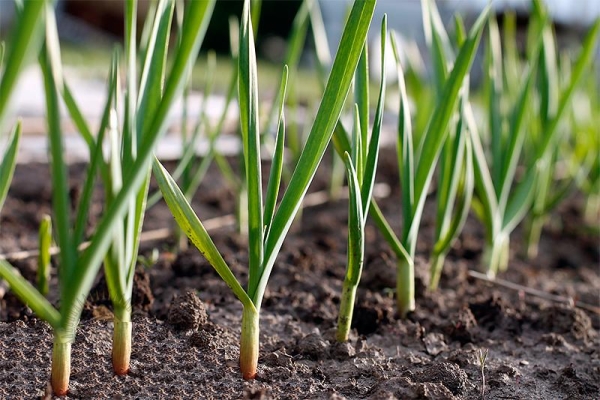
During May and June, the beds must be watered every 5-6 days.. During this period, watering is carried out once, but in such a way that the soil was always wet.
During the whole growing season it is necessary loosen the beds and remove weeds from them. Loosening is done the next day after watering.
As soon as the bulbs begin to form, it is necessary to feed phosphate-potassium fertilizer.
After 10 days fertilization is repeated. In the interval between application, preferably on the 3rd day, wood ash is added to the soil.
Even when planted in late April, garlic is not always able to ripen. From the end of July, it is necessary to control the degree of maturity of the bulb on the leaves.
If they began to dry in early August - the garlic has time to ripen.If the leaves are still fresh during this period, its maturation must be accelerated.
To accelerate the ripening of the bulbs in two ways. The first is to partially pull out the bulbs from the ground. In this case, part of the roots is injured, and all the forces of the plant go not to the growth of leaves, but to the ripening of the bulb.
In the second method, each bulb has a leaf knotted, its growth stops, and nutrients begin to accumulate intensively in the bulb. Any of these procedures is carried out in mid-August.
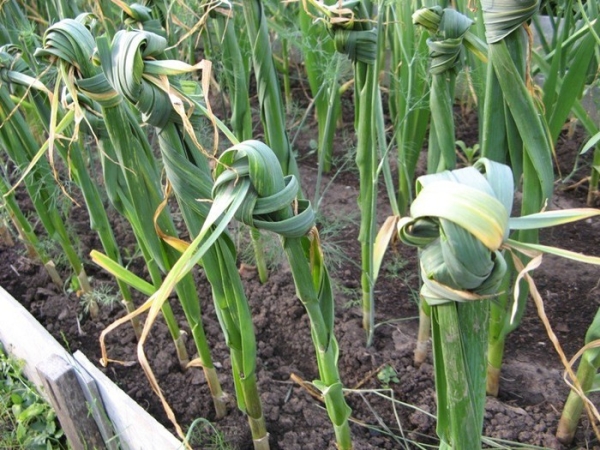
Diseases and pests
The main pests of culture are onion fly and black mold. And although garlic has an excellent protection function, it is advisable to monitor its condition.
From the onion fly helps watering with saline (200 g of salt per 10 l of water).
Against black mold fungus Well recommended spraying plants Bordeaux mixture.
Cleaning and storage
Traditionally harvesting is done in mid-September. After collecting the plants are dried: the first hour in the garden, then - under a canopy or in a well-ventilated area.
It is tied into braids and dried in limbo. At the end of the drying process, it is sent to storage, after cutting the dry leaves at a distance of 5-7 cm from the top of the head.
Store garlic in the coldest corner of the apartment (warm storage) or in the basement or refrigerator with a temperature of + 1-5 ° C (cold storage).
Tips for cleaning and storing garlic:
